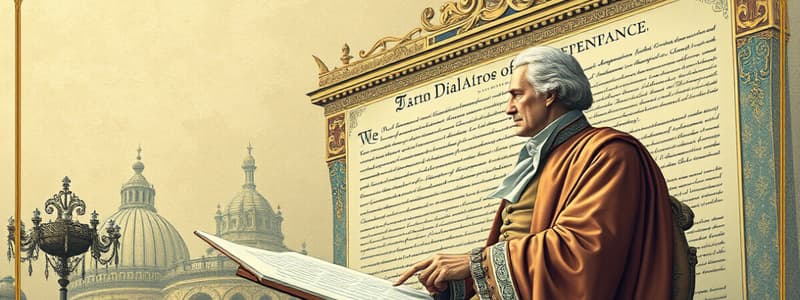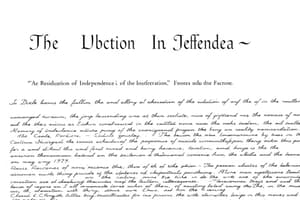Podcast
Questions and Answers
The Declaration of Independence was written by ______.
The Declaration of Independence was written by ______.
Thomas Jefferson
The phrase 'No taxation without ______' reflects the colonists' belief about British representation.
The phrase 'No taxation without ______' reflects the colonists' belief about British representation.
representation
The theory of ______ rights states that power to govern belongs to the people.
The theory of ______ rights states that power to govern belongs to the people.
natural
Thomas Paine published ______, which encouraged colonists to support independence.
Thomas Paine published ______, which encouraged colonists to support independence.
The ______ Acts imposed taxes on imported goods and tea.
The ______ Acts imposed taxes on imported goods and tea.
The ______ Continental Congress was convened in response to British policies.
The ______ Continental Congress was convened in response to British policies.
The Articles of Confederation was the first form of ______ used by the U.S. after independence.
The Articles of Confederation was the first form of ______ used by the U.S. after independence.
The ______ became the western boundary of the U.S. after the Revolutionary War.
The ______ became the western boundary of the U.S. after the Revolutionary War.
They wanted to limit the central government’s opportunities to infringe upon the people’s liberties so they established a decentralized political system in which the state governments had all the ___.
They wanted to limit the central government’s opportunities to infringe upon the people’s liberties so they established a decentralized political system in which the state governments had all the ___.
Congress depended on the states for men and money to support an ___.
Congress depended on the states for men and money to support an ___.
Shays’ Rebellion exposed the weaknesses of the Articles of ___.
Shays’ Rebellion exposed the weaknesses of the Articles of ___.
The Constitutional Convention in 1787 was called primarily because the central government needed additional ___.
The Constitutional Convention in 1787 was called primarily because the central government needed additional ___.
The Great Compromise created a bicameral ___.
The Great Compromise created a bicameral ___.
The Three-Fifths Compromise determined that ___ of the slave population would be counted for representation in the House.
The Three-Fifths Compromise determined that ___ of the slave population would be counted for representation in the House.
Delegates from states with small populations supported the idea of equal representation for the states in the national ___.
Delegates from states with small populations supported the idea of equal representation for the states in the national ___.
The Constitutional Convention was a response to Shays' ___.
The Constitutional Convention was a response to Shays' ___.
Flashcards are hidden until you start studying
Study Notes
Declaration of Independence
- Composed by Thomas Jefferson, the document outlines colonial grievances against British rule.
- Draws heavily from Enlightenment thinkers, especially John Locke’s theory of natural rights emphasizing "consent of the governed."
- Establishes the principle that the government's purpose is to protect natural rights; if it fails, it can be overthrown.
- Similar to the Bill of Rights regarding limitations on governmental power and individual liberties.
- Fueled by the mantra "No Taxation Without Representation," asserting that colonists were unfairly taxed without a voice in Parliament.
Key Influences on Independence
- Thomas Paine's "Common Sense" significantly swayed undecided colonists towards independence.
- Increased opposition to British mercantilist policies led to organized resistance, including Committees of Correspondence, Non-importation Agreements, and the Boston Tea Party.
Major Events Leading to Revolutionary War
- Sugar Act: Tax imposed on foreign molasses; Stamp Act: Tax on printed materials.
- Quartering Act required colonists to house British soldiers; Townshend Acts taxed imported goods and tea.
- The Boston Massacre resulted in the death of five colonists at the hands of British soldiers.
- War began shortly after the Declaration of Independence, with American victory aided by local knowledge and French support.
- Mississippi River established as the western boundary post-war.
Articles of Confederation
- Served as the first governing document for the U.S. after declaring independence.
- Reflected American concern over a strong central government due to experiences under British rule.
- Established a decentralized political system granting power primarily to state governments.
- Limited effectiveness: Congress had no power to enforce laws, collect taxes, or maintain a standing army.
Successes and Failures of the Articles
- Successfully created a framework for governance of Western territories and facilitated the admission of new states.
- Problems included Congress’s dependence on state resources and inability to execute national policies.
Constitutional Convention (1787)
- Convened in Philadelphia to address weaknesses in the Articles of Confederation, primarily due to over-empowered states.
- Shays' Rebellion highlighted the need for a stronger national government and catalyzed the convention.
Great Compromise
- Resolved debate over state representation in Congress: a bicameral legislature was established.
- House of Representatives based on population, while the Senate ensured equal representation for all states.
Three-Fifths Compromise
- Addressed representation from states with large slave populations by counting three-fifths of the slave population for House representation.
Other Major Compromises
- Included agreements on Slave Trade, Taxation policies, and the Election of the President, reflecting the diverse interests of states.
Studying That Suits You
Use AI to generate personalized quizzes and flashcards to suit your learning preferences.




